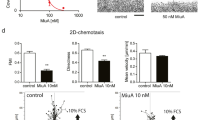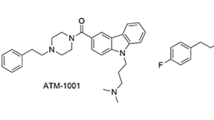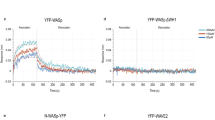Abstract
Bistramide A (1) is a marine natural product with broad, potent antiproliferative effects1,2,3,4,5,6,7. Bistramide A has been reported to selectively activate protein kinase C (PKC) δ, leading to the view that PKCδ is the principal mediator of antiproliferative activity of this natural product8. Contrary to this observation, we established that bistramide A binds PKCδ with low affinity, does not activate this kinase in vitro and does not translocate GFP-PKCδ. Furthermore, we identified actin as the cellular receptor of bistramide A. We report that bistramide A disrupts the actin cytoskeleton, inhibits actin polymerization, depolymerizes filamentous F-actin in vitro and binds directly to monomeric G-actin in a 1:1 ratio with a Kd of 7 nM. We also constructed a fully synthetic9 bistramide A–based affinity matrix and isolated actin as a specific bistramide A–binding protein. This activity provides a molecular explanation for the potent antiproliferative effects of bistramide A, identifying it as a new biochemical tool for studies of the actin cytoskeleton and as a potential lead for development of a new class of antitumor agents7,10.
This is a preview of subscription content, access via your institution
Access options
Subscribe to this journal
Receive 12 print issues and online access
$259.00 per year
only $21.58 per issue
Buy this article
- Purchase on Springer Link
- Instant access to full article PDF
Prices may be subject to local taxes which are calculated during checkout




Similar content being viewed by others
References
Gouiffès, D. et al. Proton nuclear magnetic study of bistramide A, a new cytotoxic drug isolated from Lissoclinum bistratum Sluiter. Tetrahedron 44, 451459 (1988).
Degnan, B.M. et al. Novel cytotoxic compounds from the ascidian Lissoclinum Bistratum. J. Med. Chem. 32, 1354–1359 (1989).
Biard, J.F., Roussakis, C., Kornprobst, J.M., Gouffes-Barbin, D. & Verbist, J.F. Bistramides A, B, C, D, and K: a new class of bioactive cyclic polyethers from Lissoclinum Bistratum. J. Nat. Prod. 57, 1336–1345 (1994).
Gouiffès, D. et al. Bistramide A, a new toxin from the urochordata Lissoclinum bistratum Sluiter: isolation and preliminary characterization. Toxicon 26, 1129–1136 (1988).
Sauviat, M.P. & Verbist, J.F. Alteration of the voltage-dependence of the twitch tension in frog skeletal muscle fibres by a polyether, bistramide A. Gen. Physiol. Biophys. 12, 465–471 (1993).
Sauviat, M.P., Gouiffes-Barbin, D., Ecault, E. & Verbist, J.F. Blockades of sodium channels by bistramide A in voltage-clamped frog skeletal muscles fibres. Biochim. Biophys. Acta 1103, 109–114 (1992).
Riou, D., Roussakis, C., Biard, J.F. & Verbist, J.F. Comparative study of the antitumor activity of bistramides A, D and K against a non-small cell broncho-pulmonary carcinoma. Anticancer Res. 13, 2331–2334 (1993).
Griffiths, G. et al. The polyether bistratene A activates protein kinase C-δ and induces growth arrest in HL-60. Biochem. Biophys. Res. Commun. 222, 802–808 (1996).
Statsuk, A.V., Liu, D. & Kozmin, S.A. Synthesis of bistramide A. J. Am. Chem. Soc. 126, 9546–9547 (2004).
Jordan, M.A. & Wilson, L. Microtubules and actin filaments: dynamic targets for cancer chemotherapy. Curr. Opin. Cell Biol. 10, 123–130 (1998).
Frey, M.R., Leontieva, O., Waters, D.J. & Black, J.D. Stimulation of protein kinase C-dependent and independent signalling pathways by bistratene A in intestinal epithelial cells. Biochem. Pharmacol. 61, 1093–1100 (2001).
Sun, H. et al. Real-time protein kinase assay. Anal. Chem. 77, 2043–2049 (2005).
Wender, P.A. et al. R The design, computer modeling, solution structure, and biological evaluation of synthetic analogs of bryostatin 1. Proc. Natl. Acad. Sci. USA 95, 6624–6629 (1998).
Wang, Q.J. et al. Differential localization of protein kinase C δ by phorbol esters and related compounds using fusion protein with green fluorescent protein. J. Biol. Chem. 274, 37233–37239 (1999).
Baryza, J.L., Brenner, S.E., Craske, M.L., Meyer, T. & Wender, P.A. Simplified analogs of bryostatin with anticancer activity display greater potency for translocation of PKC δ -GFP. Chem. Biol. 11, 1261–1267 (2004).
Roussakis, C. et al. Effects of bistramide A on a non-small-cell bronchial carcinoma line. Cancer Chemother. Pharmacol. 28, 283–292 (1991).
Watters, D.J., Beamish, H.J., Marshall, K.A., Gardiner, R.A., Seymour, G.J. & Lavin, M.F. Accumulation of HL-60 cells in G2/M and inhibition of cytokinesis caused by two marine compounds, bistratene A and cycloxazoline. Cancer Chemother. Pharmacol. 33, 399–409 (1994).
Glotzer, M. The molecular requirements for cytokinesis. Science 307, 1735–1739 (2005).
Spector, I., Shochet, N., Blasberger, D. & Kashman, Y. Latrunculins – novel marine metabolites that disrupt microfilament organization and affect cell growth: 1. Comparison with cytochalisin D. Cell Motil. Cytoskeleton 13, 127–144 (1989).
Bubb, M.R., Senderowicz, A.M.J., Sausville, E.A., Duncan, K.L.K. & Korn, E.D. Jasplakinolide, a cytotoxic natural product, induces actin polymerization and competitively inhibits the binding of phalloidin to F-actin. J. Biol. Chem. 269, 14869–14871 (1994).
Saito, S., Watabe, S., Ozaki, H., Fusetani, N. & Karaki, H. Mycalolide B, a novel actin depolymerizing agent. J. Biol. Chem. 269, 29710–29714 (1994).
Bubb, M.R., Spector, I., Bershadsky, A.D. & Korn, E.D. Swinholide A is a microfilament disrupting marine toxin that stabilizes actin dimers and severs actin filaments. J. Biol. Chem. 270, 3463–3466 (1995).
Saito, S. et al. Novel actin depolymerizing macrolide aplyronine A. J. Biochem. 120, 552–555 (1996).
Terry, D.R., Spector, I., Higa, T. & Bubb, M.R. Misakinolide A is a marine macrolide that caps but does not sever filamentous actin. J. Biol. Chem. 272, 7841–7845 (1997).
Bai, R. et al. Dolastatin 11, a marine depsipeptide, arrests cells at cytokinesis and induces hyperpolymerization of purified actin. Mol. Pharmacol. 59, 462–469 (2001).
Marquez, B.L. et al. Structure and absolute stereochemistry of hectochlorin, a potent stimulator of actin assembly. J. Nat. Prod. 65, 866–871 (2002).
Bai, R., Covell, D.G., Liu, C., Ghosh, A.G. & Hamel, E. (-)-Doliculide, a new macrocyclic depsipeptide enhancer of actin assembly. J. Biol. Chem. 277, 32165–32171 (2002).
Yeung, K.S. & Paterson, I. Actin-binding marine metabolites: total synthesis and biological importance. Angew. Chem. Int. Edn. Engl. 41, 4632–4653 (2002).
Klenchin, V.A. et al. Trisoxazole macrolide toxins mimic the binding of actin-capping proteins to actin. Nat. Struct. Biol. 10, 1058–1063 (2003).
Chatterjee, A.K., Morgan, J.P., Scholl, M. & Grubbs, R.H. Synthesis of functionalized olefins by cross and ring-closing metatheses. J. Am. Chem. Soc. 122, 3783–3784 (2000).
Acknowledgements
We thank G.F. Biard for a generous sample of natural bistramide A and Y. Lee for assistance with an affinity purification procedure. We also thank T. Meyer for imaging assistance and plasmids and D. Mochly-Rosen for binding assay support. Financial support was provided by the American Cancer Society (RSG-04-017-CDD) and the US National Institutes of Health (Grant CA31845). A.V.S. acknowledges the support of Burroughs Wellcome Fund Interfaces #1001774. J.L.B. is supported by an ACS Medicinal Chemistry Predoctoral Fellowship. S.A.K. thanks the Dreyfus Foundation for a Teacher-Scholar Award, Amgen for a New Investigator's Award and GlaxoSmithKline for a Chemistry Scholars Award. S.A.K. is a fellow of the Alfred P. Sloan Foundation.
Author information
Authors and Affiliations
Corresponding author
Ethics declarations
Competing interests
The authors declare no competing financial interests.
Supplementary information
Supplementary Fig. 1
Effect of bistramide A on cancer cell cycle. (PDF 382 kb)
Supplementary Fig. 2
Thermodynamic parameters of actin-latrunculin A binding. (PDF 349 kb)
Supplementary Fig. 3
Purification of bistramide A-binding proteins using affinity matrix. (PDF 181 kb)
Supplementary Table 1
Cancer cell growth and viability assays for bistramide A. (PDF 166 kb)
Rights and permissions
About this article
Cite this article
Statsuk, A., Bai, R., Baryza, J. et al. Actin is the primary cellular receptor of bistramide A. Nat Chem Biol 1, 383–388 (2005). https://doi.org/10.1038/nchembio748
Received:
Accepted:
Published:
Issue Date:
DOI: https://doi.org/10.1038/nchembio748
This article is cited by
-
Expression and Functional Characterization of Tumor-Targeted Fusion Protein Composed of NGR Peptide and 15-kDa Actin Fragment
Applied Biochemistry and Biotechnology (2010)



